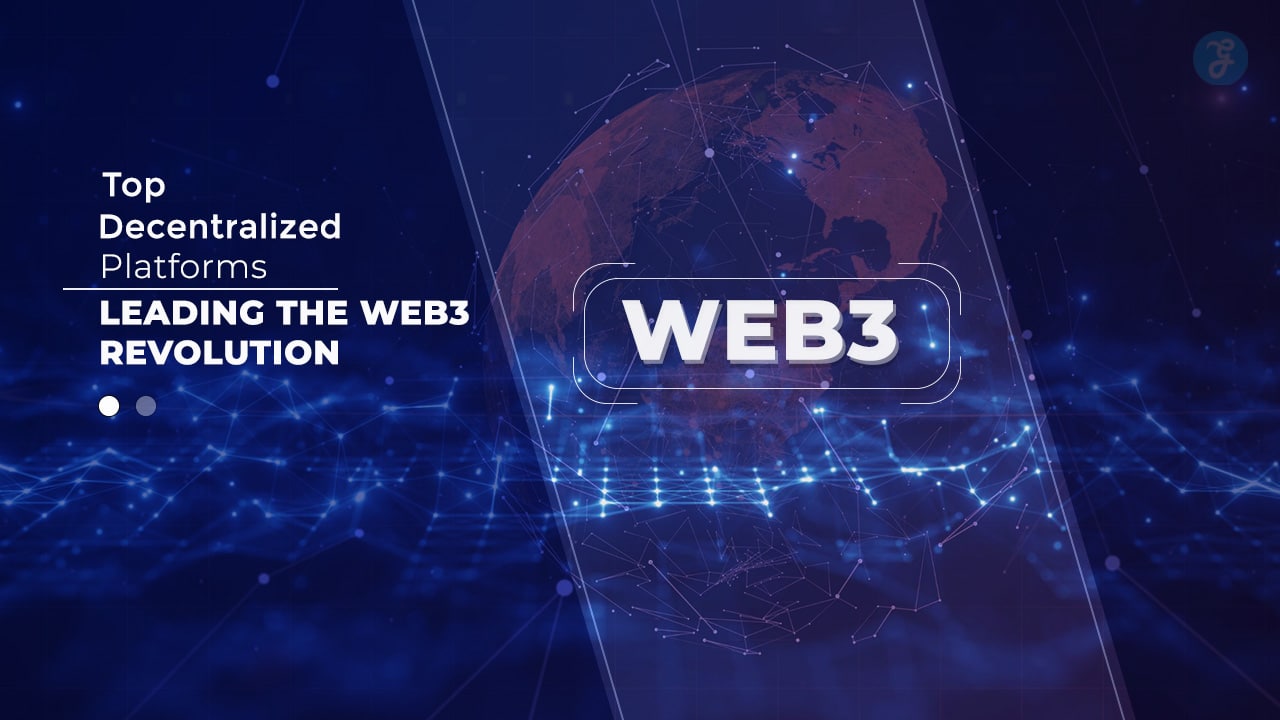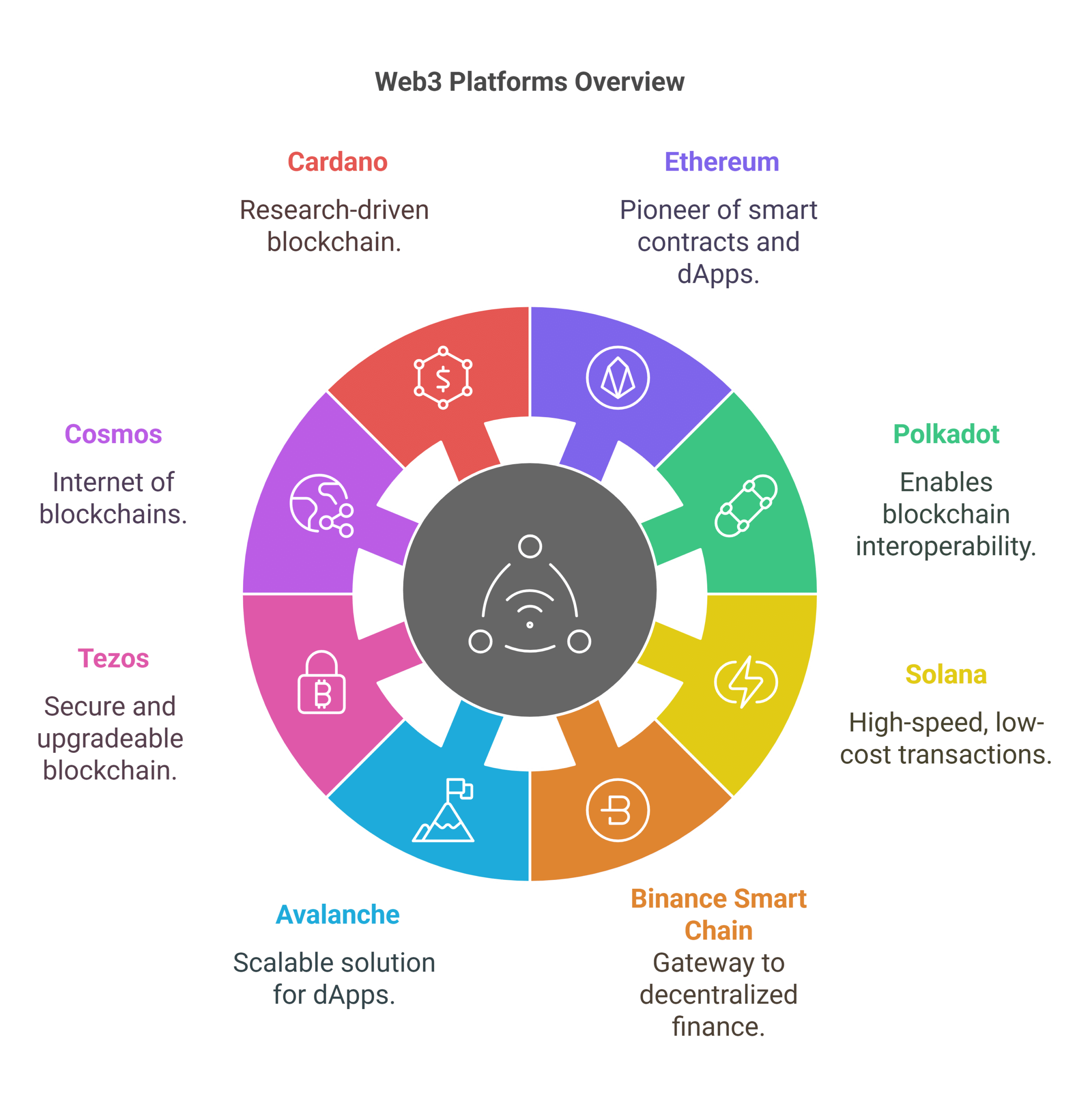As the Web3 revolution takes center stage, decentralized platforms are transforming how we interact with technology. These platforms prioritize user ownership, transparency, and decentralization, standing in stark contrast to traditional, centralized systems.
From reshaping finance to enabling trustless applications, decentralized platforms are at the core of this technological paradigm shift.
This article explores the top 10 decentralized platforms leading the Web3 revolution, showcasing their unique features, contributions, and real-world impact.
Why Decentralized Platforms Matter in Web3
- Decentralized platforms eliminate intermediaries, empowering users with direct control.
- They enhance security through blockchain’s immutable and transparent nature.
- As the foundation of Web3, they foster innovation in areas like DeFi, NFTs, and dApps.
How We Selected These Platforms
- Innovation: Platforms introducing groundbreaking technology or use cases.
- Adoption: Those with robust user bases and growing ecosystems.
- Impact: Measurable contributions to advancing the decentralized web.
Top 10 Decentralized Platforms Leading the Web3 Revolution
Here, we put the top 10 decentralized platforms that are leading the Web3 revolution in 2025 and beyond.
1. Ethereum: The Pioneer of Smart Contracts
Ethereum, the second-largest blockchain by market capitalization, introduced smart contracts, allowing developers to build decentralized applications (dApps). Its versatility has positioned it as the backbone of the Web3 ecosystem, hosting a wide range of projects across DeFi, NFTs, and DAOs.
Key Features:
- Smart contract capabilities enabling DeFi, NFTs, and DAO development.
- Ethereum Virtual Machine (EVM) as a global computational environment.
- Transition to Ethereum 2.0 with proof-of-stake for enhanced scalability and sustainability.
Notable Projects:
- Uniswap: A decentralized exchange revolutionizing token swaps.
- OpenSea: The leading NFT marketplace driving digital asset adoption.
Impact: Ethereum remains a cornerstone of Web3, hosting over 70% of all dApps and contributing significantly to decentralized finance and NFT adoption. Its ongoing upgrades ensure it remains competitive in a rapidly evolving ecosystem.
| Feature | Description | Example Use Case |
| Smart Contracts | Trustless automation of agreements | DeFi lending platforms |
| dApps | Decentralized applications for various needs | Gaming, DeFi, NFTs |
| Ethereum 2.0 Upgrade | Scalable and energy-efficient blockchain | Future DeFi scaling |
2. Polkadot: Enabling Blockchain Interoperability
Polkadot connects multiple blockchains into a single network, enabling seamless data and asset transfers. Its focus on interoperability addresses one of Web3’s biggest challenges: enabling blockchains to communicate effectively.
Key Features:
- Parachains for scalable, customizable blockchain applications.
- Shared security model ensuring network integrity.
- Interoperability through cross-chain messaging protocols.
Notable Use Cases:
- Cross-chain DeFi protocols leveraging Polkadot’s infrastructure.
- Parachain auctions driving network innovation and growth.
Impact: Polkadot’s innovative architecture allows different blockchain ecosystems to collaborate and scale efficiently. This positions it as a critical enabler for Web3’s interconnected future.
| Feature | Description | Example Projects |
| Parachains | Custom blockchains connected to Polkadot | Moonbeam, Acala |
| Interoperability | Cross-chain communication | ChainX, Interlay |
| Shared Security | Unified security model across parachains | Secures smaller projects |
3. Solana: High-Speed, Low-Cost Blockchain
Known for its lightning-fast transaction speeds and low fees, Solana powers scalable dApps and DeFi solutions. Its focus on performance has made it one of the most attractive platforms for developers seeking to build large-scale applications.
Key Features:
- Proof of History (PoH) for timestamping transactions, ensuring fast processing.
- Industry-leading throughput, handling up to 65,000 transactions per second.
- Affordable transaction costs, making it accessible for both developers and users.
Popular Projects:
- Serum: A high-performance decentralized exchange.
- Magic Eden: A vibrant NFT marketplace with a growing user base.
Impact: Solana’s ability to handle high volumes of transactions at low costs makes it a favorite for developers seeking scalable Web3 solutions. Its growing ecosystem spans DeFi, GameFi, and NFTs.
| Feature | Benefit | Use Case |
| High Throughput | Processes thousands of transactions per second | Real-time trading apps |
| Low Fees | Reduces barriers for dApp adoption | Micro-transactions in DeFi |
| Developer-Friendly | Robust tooling and SDKs | Gaming and marketplaces |
4. Binance Smart Chain (BSC): The Gateway to DeFi
BSC offers a dual-chain architecture, combining low-cost transactions with cross-chain interoperability. This makes it a popular choice for DeFi projects seeking scalability and affordability.
Key Features:
- Compatibility with Ethereum’s EVM, enabling easy migration of dApps.
- Robust DeFi ecosystem featuring yield farming, staking, and lending.
- High throughput with low transaction fees.
Notable Projects:
- PancakeSwap: A decentralized exchange enabling token swaps and staking.
- Venus: A decentralized lending platform offering algorithmic stablecoins.
Impact: BSC’s rapid adoption underscores its importance in democratizing DeFi for a global audience. Its low-cost infrastructure has attracted millions of users to its ecosystem.
| Feature | Description | Example Projects |
| EVM Compatibility | Easy migration for Ethereum dApps | PancakeSwap, Venus |
| Yield Farming | Rewards for liquidity provision | Beefy Finance |
| Low Fees | Accessible to users worldwide | GameFi applications |
5. Avalanche: The Scalable Solution for dApps
Avalanche enables developers to launch scalable dApps and enterprise-grade blockchains with ease. Its consensus mechanism and customizable subnets provide unparalleled flexibility and speed.
Key Features:
- Subnets for creating customized blockchains tailored to specific use cases.
- Avalanche Consensus Protocol ensuring high throughput and low latency.
- Eco-friendly approach with energy-efficient operations.
Real-World Use Cases:
- DeFi projects optimizing speed and security.
- Enterprise adoption for asset tokenization and supply chain solutions.
Impact: Avalanche’s modular architecture and focus on scalability position it as a key player in Web3’s evolution. Its ability to handle diverse use cases sets it apart from traditional blockchain platforms.
| Feature | Description | Example Use Case |
| Custom Subnets | Specialized blockchain deployments | DeFi and GameFi |
| High Scalability | Supports high transaction volumes | Real-time finance apps |
| Eco-Friendly | Low environmental impact | Green NFTs |
6. Tezos: Secure, Upgradeable Blockchain
Tezos is a self-amending blockchain prioritizing security, scalability, and sustainability. Unlike traditional blockchains, Tezos can upgrade itself without requiring hard forks, ensuring network continuity and reducing disruption.
Key Features:
- On-chain governance for seamless upgrades and decision-making.
- Energy-efficient consensus mechanism using Liquid Proof-of-Stake (LPoS).
- Secure smart contracts verified through formal methods.
Applications:
- Adoption in eco-friendly NFTs, such as the Hic et Nunc marketplace.
- Enterprise solutions for tokenized assets and identity management.
Impact: Tezos’s self-amending capabilities make it a sustainable choice for long-term blockchain innovation. Its energy-efficient model aligns with the growing demand for eco-conscious technology.
| Feature | Description | Example Projects |
| On-Chain Governance | Enables seamless protocol upgrades | Tezos Agora |
| Energy Efficiency | Reduced carbon footprint | Green NFT marketplaces |
| Formal Verification | Ensures robust and secure smart contracts | Enterprise solutions |
7. Cosmos: The Internet of Blockchains
Cosmos facilitates interoperability between blockchains, enabling seamless interaction and collaboration among various ecosystems. Its modular approach simplifies the development of application-specific blockchains.
Key Features:
- Tendermint BFT consensus for high-speed and secure transactions.
- Cosmos SDK for building custom blockchain solutions.
- Inter-Blockchain Communication (IBC) for cross-chain data transfer.
Ecosystem Highlights:
- Terra’s algorithmic stablecoins and decentralized finance platforms.
- Kava’s DeFi lending solutions and Osmosis’s DEX capabilities.
Impact: Cosmos is a key enabler of Web3’s decentralized architecture, fostering collaboration and innovation across multiple blockchain ecosystems.
| Feature | Description | Example Use Case |
| IBC Protocol | Enables seamless cross-chain communication | Terra-Luna integration |
| Cosmos SDK | Simplifies blockchain development | Custom financial services |
| Tendermint Consensus | Provides speed and security | Real-time transactions |
8. Cardano: A Research-Driven Blockchain
Built on peer-reviewed academic research, Cardano emphasizes security, scalability, and sustainability. Its layered architecture separates computation and settlement, optimizing performance and flexibility.
Key Features:
- Ouroboros, a groundbreaking proof-of-stake protocol ensuring security and efficiency.
- Formal verification methods to enhance smart contract robustness.
- Energy-efficient operations compared to proof-of-work blockchains.
Notable Projects:
- MELD’s decentralized banking services.
- SundaeSwap, a decentralized exchange with growing adoption.
Impact: Cardano’s commitment to scientific rigor and energy efficiency makes it a strong contender for building a sustainable and secure decentralized future.
| Feature | Description | Example Projects |
| Ouroboros Protocol | Secure and energy-efficient consensus | Cardano mainnet |
| Layered Architecture | Separates data processing and settlement | Enhanced scalability |
| Academic Research | Peer-reviewed innovation | MELD, SundaeSwap |
9. Filecoin: Decentralized Storage Network
Filecoin revolutionizes the storage industry by creating a decentralized, trustless system where users are incentivized to provide storage space. It addresses the inefficiencies and vulnerabilities of centralized cloud storage providers.
Key Features:
- Trustless, peer-to-peer data storage marketplace.
- Integration with decentralized applications and NFT platforms.
- Proof-of-Replication and Proof-of-Spacetime consensus mechanisms ensuring storage reliability.
Applications:
- Content delivery networks for decentralized media.
- Secure, scalable data storage solutions for enterprises.
Impact: Filecoin’s decentralized model solves critical challenges in data storage, paving the way for Web3 applications that require secure and scalable solutions.
| Feature | Description | Example Use Case |
| Decentralized Storage | Eliminates reliance on centralized providers | NFT metadata storage |
| Incentive Mechanisms | Encourages participation from storage providers | Peer-to-peer networks |
| Data Security | Ensures immutability and privacy | Enterprise backups |
10. Chainlink: The Decentralized Oracle Network
Chainlink connects smart contracts with real-world data, enabling advanced functionalities and bridging the gap between blockchain ecosystems and external systems.
Key Features:
- Secure, decentralized data feeds for price, weather, and other critical information.
- Wide integration with major blockchain platforms and applications.
- Supports hybrid smart contracts for enhanced use cases.
Key Use Cases:
- DeFi platforms relying on accurate price oracles, such as Aave and Synthetix.
- Insurance solutions using real-time weather data for automated payouts.
Impact: Chainlink’s decentralized oracle network is indispensable for bringing external data into blockchain ecosystems, making it a foundational component of Web3 infrastructure.
| Feature | Description | Example Projects |
| Price Oracles | Accurate and decentralized data feeds | Aave, Synthetix |
| Real-Time Integration | Enables dynamic smart contract execution | Parametric insurance |
| Blockchain Agnostic | Works across multiple blockchain ecosystems | Cross-chain applications |
Takeaways
As the Web3 revolution unfolds, decentralized platforms leading the Web3 revolution are redefining the digital landscape by prioritizing transparency, user empowerment, and innovation.
The platforms highlighted in this article showcase the immense potential of blockchain technology to disrupt traditional systems and pave the way for a decentralized future. From Ethereum’s pioneering smart contracts to Chainlink’s reliable oracle networks, each platform contributes uniquely to the Web3 ecosystem.
For individuals and businesses eager to embrace this transformative era, understanding and exploring these decentralized platforms leading the Web3 revolution is key. Whether it’s leveraging DeFi for financial independence, creating eco-friendly NFTs, or building interoperable dApps, the possibilities are endless.
Join the Web3 revolution by engaging with these decentralized platforms leading the Web3 revolution, and be a part of the future where decentralization empowers us all.










































